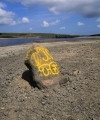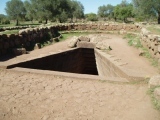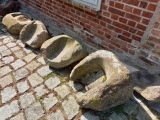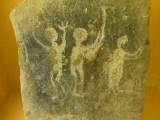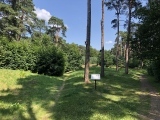Andy Burnham's Blog, page 162
August 31, 2021
Northern Earth Issue 165 Out Now
In this issue: A View Over a Hill - Stuart McHardy offers a geomythographical interpretation of a Shropshire hill
Faces in Stone - Simulacra are archaeologically known to have had significance to past cultures; might they also have had a route-finding function, asks Gabriel Blamires?
Starry Paths in Stone - Simon Crook draws a line between community traditions in prehistory and the drift towards the private and dynastic in modernity
The Alfred Watkins Vision Centenary 2021 - Christine Rhone and others marked the day. And more...
Faces in Stone - Simulacra are archaeologically known to have had significance to past cultures; might they also have had a route-finding function, asks Gabriel Blamires?
Starry Paths in Stone - Simon Crook draws a line between community traditions in prehistory and the drift towards the private and dynastic in modernity
The Alfred Watkins Vision Centenary 2021 - Christine Rhone and others marked the day. And more...
Published on August 31, 2021 10:40
Uyea Breck
A video of an archaeoastronomy investigation of the possible alignments with this stone and the nearby Clivocast standing stone. The summer solstice sunrise alignment is particularly interesting and has not been documented before to our knowledge. Details in the comments on our page.. Standing Stone in Shetland. An amazing 3m (9 foot 10 inch) tall schist monolith leaning towards the north east. The stone is said to mark the spot where the son of Viking Harald Harfager was killed about 900 AD. He is said to be buried in a tumulus to the SW. It measures 0.86m (2 feet 10 inches) wide at the base where it is supported by a packing of small stones. It's broader face is aligned almost north-south. The stone is outside the village of Uyeasound, on Unst, northernmost of the Shetland Isles. It is the northernmost of the two marked on the OS map.
Published on August 31, 2021 03:51
August 30, 2021
The Braunston Goddess
Sculpted stone in Rutland. The stone is at the west end of the village church, against the tower. The stone was found in 1920 during renovations. It was face down and being used as a doorstop. The date and origin of the are unknown.
Published on August 30, 2021 10:11
August 29, 2021
Aled Isaf Reservoir Standing Stone
The reservoir has been drained for repair work so the standing stone in the reservoir and usually under water could be visited as of about a month ago (July 2021). I'm not sure if it is still accessible. The stone is 20m from the road and a short way south of the dam. Unfortunately it now has graffiti on it.
Published on August 29, 2021 06:42
August 28, 2021
Santa Cristina Pozzo Sacro
An extremely precisely masoned stairwell to a sacred well in Sardinia, dating from the end of the Bronze Age. The central well is a tholos with a small light opening on the top. There is still water in the well The well is surrounded by a tear drop shaped stone enclosure which contrasts with the modernistic appearance of the well. South east facing.
Published on August 28, 2021 02:37
August 25, 2021
Mahlsteine im Heimatmuseum Fürstenwerder
A collection of 18 prehistoric and early historic grinding stones / millstones in the backyard of the Heimatmuseum in Fürstenwerder, Brandenburg. To visit the stones, the Museum, the Tourist Information or the nearby Restaurant Else Förster must be open.
Published on August 25, 2021 12:43
August 24, 2021
Niedersächsischen Landesmuseums Hannover
The Landesmuseum in Hannover exhibits many typical prehistoric artefacts, and has vivid showcases. The masterpiece on display is the Anderlingen Bildstein carvings of three human figures (see photo), which were carved on the end panel of a chambered tomb. The actual tomb they came from has been rescued and reconstructed in the grounds of the museum.
Published on August 24, 2021 15:03
August 22, 2021
Båstad Gravfält
Situated in the forest on the eastern side of Båstad (Skåne, Sweden) are the remains of a "gravfält" ie. a grave field containing the remains of 13 burial mounds from the Bronze Age. The majority of the site is hidden beneath the overgrowth, making it hard to see the entire thing, but a section of it has been cleared. The largest mound in the centre of the grave field.
Published on August 22, 2021 11:06
Båstad Menhirs
Situated next to the tennis courts in the southern part of Båstad in Skåne, Sweden are two standing stones. The standing stones are placed at the bottom of a gravel path and with a large tree between them both. The two stones are believed to have been raised during the Iron Age and placed over burials from that period.
Published on August 22, 2021 11:05
August 21, 2021
Japanese Chronology for Kofun burial mounds (Kofun era. 3rd-7th C)
The origin of the Kofun burial mound started in the early Yayoi era (around 600 BCE), old burial systems such as pit, coffin, cist or jar burials shifted to rectangular burial mounds with a surrounding moat, in the mid Yayoi era (200-0 BCE) other variations e.g. rectangular or round mounds with or without moat appeared. Photo left: In the 5th century, the burial system gradually shifted from vertical pit to horizontal chambers with entrance passage, see further down for more details
Published on August 21, 2021 07:05



